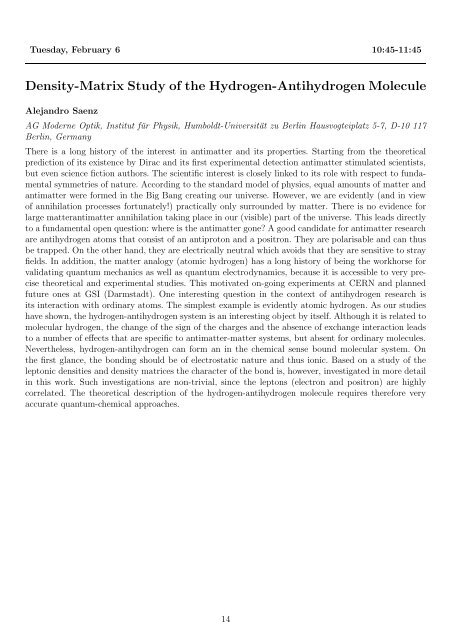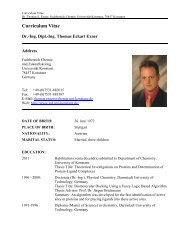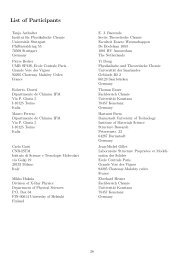The Role of the Lone Pairs in Hydrogen Bonding
The Role of the Lone Pairs in Hydrogen Bonding
The Role of the Lone Pairs in Hydrogen Bonding
You also want an ePaper? Increase the reach of your titles
YUMPU automatically turns print PDFs into web optimized ePapers that Google loves.
Tuesday, February 6 10:45-11:45<br />
Density-Matrix Study <strong>of</strong> <strong>the</strong> <strong>Hydrogen</strong>-Antihydrogen Molecule<br />
Alejandro Saenz<br />
AG Moderne Optik, Institut für Physik, Humboldt-Universität zu Berl<strong>in</strong> Hausvogteiplatz 5-7, D-10 117<br />
Berl<strong>in</strong>, Germany<br />
<strong>The</strong>re is a long history <strong>of</strong> <strong>the</strong> <strong>in</strong>terest <strong>in</strong> antimatter and its properties. Start<strong>in</strong>g from <strong>the</strong> <strong>the</strong>oretical<br />
prediction <strong>of</strong> its existence by Dirac and its first experimental detection antimatter stimulated scientists,<br />
but even science fiction authors. <strong>The</strong> scientific <strong>in</strong>terest is closely l<strong>in</strong>ked to its role with respect to fundamental<br />
symmetries <strong>of</strong> nature. Accord<strong>in</strong>g to <strong>the</strong> standard model <strong>of</strong> physics, equal amounts <strong>of</strong> matter and<br />
antimatter were formed <strong>in</strong> <strong>the</strong> Big Bang creat<strong>in</strong>g our universe. However, we are evidently (and <strong>in</strong> view<br />
<strong>of</strong> annihilation processes fortunately!) practically only surrounded by matter. <strong>The</strong>re is no evidence for<br />
large matterantimatter annihilation tak<strong>in</strong>g place <strong>in</strong> our (visible) part <strong>of</strong> <strong>the</strong> universe. This leads directly<br />
to a fundamental open question: where is <strong>the</strong> antimatter gone? A good candidate for antimatter research<br />
are antihydrogen atoms that consist <strong>of</strong> an antiproton and a positron. <strong>The</strong>y are polarisable and can thus<br />
be trapped. On <strong>the</strong> o<strong>the</strong>r hand, <strong>the</strong>y are electrically neutral which avoids that <strong>the</strong>y are sensitive to stray<br />
fields. In addition, <strong>the</strong> matter analogy (atomic hydrogen) has a long history <strong>of</strong> be<strong>in</strong>g <strong>the</strong> workhorse for<br />
validat<strong>in</strong>g quantum mechanics as well as quantum electrodynamics, because it is accessible to very precise<br />
<strong>the</strong>oretical and experimental studies. This motivated on-go<strong>in</strong>g experiments at CERN and planned<br />
future ones at GSI (Darmstadt). One <strong>in</strong>terest<strong>in</strong>g question <strong>in</strong> <strong>the</strong> context <strong>of</strong> antihydrogen research is<br />
its <strong>in</strong>teraction with ord<strong>in</strong>ary atoms. <strong>The</strong> simplest example is evidently atomic hydrogen. As our studies<br />
have shown, <strong>the</strong> hydrogen-antihydrogen system is an <strong>in</strong>terest<strong>in</strong>g object by itself. Although it is related to<br />
molecular hydrogen, <strong>the</strong> change <strong>of</strong> <strong>the</strong> sign <strong>of</strong> <strong>the</strong> charges and <strong>the</strong> absence <strong>of</strong> exchange <strong>in</strong>teraction leads<br />
to a number <strong>of</strong> effects that are specific to antimatter-matter systems, but absent for ord<strong>in</strong>ary molecules.<br />
Never<strong>the</strong>less, hydrogen-antihydrogen can form an <strong>in</strong> <strong>the</strong> chemical sense bound molecular system. On<br />
<strong>the</strong> first glance, <strong>the</strong> bond<strong>in</strong>g should be <strong>of</strong> electrostatic nature and thus ionic. Based on a study <strong>of</strong> <strong>the</strong><br />
leptonic densities and density matrices <strong>the</strong> character <strong>of</strong> <strong>the</strong> bond is, however, <strong>in</strong>vestigated <strong>in</strong> more detail<br />
<strong>in</strong> this work. Such <strong>in</strong>vestigations are non-trivial, s<strong>in</strong>ce <strong>the</strong> leptons (electron and positron) are highly<br />
correlated. <strong>The</strong> <strong>the</strong>oretical description <strong>of</strong> <strong>the</strong> hydrogen-antihydrogen molecule requires <strong>the</strong>refore very<br />
accurate quantum-chemical approaches.<br />
14






